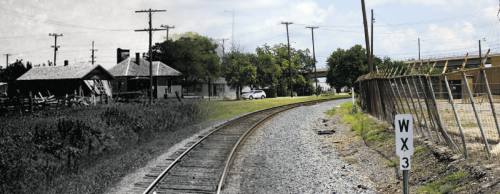 A plan for a passenger rail line that would connect downtown Plano to Dallas/Fort Worth International Airport has hit political roadblocks, leaving developers and officials uncertain when the rail line is expected to become operational.
A plan for a passenger rail line that would connect downtown Plano to Dallas/Fort Worth International Airport has hit political roadblocks, leaving developers and officials uncertain when the rail line is expected to become operational.
 Dallas Area Rapid Transit board members have failed to reach consensus over funding for the 26-mile Cotton Belt line, and Plano City Council members have publicly expressed concern over the future of the project, which they expect would boost redevelopment efforts in the city’s southeast corner.
Dallas Area Rapid Transit board members have failed to reach consensus over funding for the 26-mile Cotton Belt line, and Plano City Council members have publicly expressed concern over the future of the project, which they expect would boost redevelopment efforts in the city’s southeast corner.
The city of Dallas has appointed four new members this year to the DART board, and one of its councilmen has called for prioritizing a subway project in downtown Dallas over the long-discussed suburban Cotton Belt line.
DART staff maintain they can fund both a downtown Dallas subway project and the Cotton Belt simultaneously. Dallas City Council Member Philip Kingston has openly questioned that conclusion, and is pushing for the prioritization of the Dallas project, which is known as the D2 subway.
“Even if you think [the Cotton Belt line] is a great project, no one who really is a transit advocate would put the Cotton Belt at a higher priority than the D2,” Kingston said.
But Kingston’s views on the importance of the D2 are not shared by the suburban cities in the DART system. The rail line would run through Plano and other northern Dallas suburbs such as Richardson and Addison.
 “You need an east-west element to make the network fully functional, and right now, that’s something that’s lacking in the passenger rail network,” Plano Director of Planning Christina Day said.
“You need an east-west element to make the network fully functional, and right now, that’s something that’s lacking in the passenger rail network,” Plano Director of Planning Christina Day said.
DART staff and board members have discussed voting to move forward with Cotton Belt funding by September—a resolution that has failed to pass twice in the last year, which is cause for concern among Plano officials.
A boon for southeast Plano Shortly after the Dallas council appointed a group of new board members on June 28, Plano Council Member Rick Grady said he was concerned about public statements they made that he said could serve as “a huge rail-block” to the interests of the suburban cities like Plano.
In 2016, DART received approximately $76 million from Plano sales taxes to fund its operations—about 14 percent of all sales tax revenue. Plano has two light-rail rail stations in its southeast corner, one at Parker Road and another at 15th Street. The proposed Cotton Belt line would link with the existing north-south rail system and add a new station at Plano’s 12th Street and another at Shiloh Road.
 Plano officials have had their eyes on the Cotton Belt corridor since 1983, when they first became a DART-participating city and DART was making its mark as a regional transportation agency.
Plano officials have had their eyes on the Cotton Belt corridor since 1983, when they first became a DART-participating city and DART was making its mark as a regional transportation agency.
“If you look at the 15th Street core of downtown Plano, the vitality of the business community there is dramatically different today than it was in the mid-’90s,” Day said. “And I think that is part and parcel of the renaissance where the DART station played a major role.”
But in addition to transporting riders to the airport and back, Plano officials believe the Cotton Belt line could be the catalyst for serious economic growth in southeast Plano, where it would intersect with the existing north-south rail line hugging the US 75 corridor.
“[The Cotton Belt] is basically a really unique opportunity to expand our downtown core to the south and … continue what we hope is a synergy between downtown Plano and CityLine station—revitalizing that southern K Avenue corridor in Plano,” Day said.
In fact, the prospect of a future Cotton Belt line was one of the factors that attracted the attention of KDC, the commercial developer behind projects like Toyota’s North American headquarters in Plano, to construct Richardson’s CityLine development. Walt Mountford, the KDC development executive responsible for CityLine, said KDC officials were aware of the possibility of a future Cotton Belt line when they originally purchased the property just south of the Richardson-Plano border.
“We would like to get the Cotton Belt initiated as soon as possible,” Mountford said. “I think everyone has to look within legitimately reasonable means to accomplish that. If DART has the financing and they can put together the project, we’re fully supportive of accelerating it.”
Uncertain financing While DART participating suburbs and commercial developers have been pulling for the east-west running rail, DART has recently taken steps to advance the D2 subway project. A committee of DART board members voted Aug. 8 to recommend acquiring the necessary rights-of-way that would facilitate the construction of the downtown tunnel, which will primarily run underneath Commerce Street and connect parts of east and west downtown Dallas.
However, such large capital projects like the D2 subway and the Cotton Belt line come with heavy financial implications. Over the span of their construction, DART staff expects the Cotton Belt project to cost about $1.1 billion and the D2 subway to cost about $1.3 billion. DART staff have proposed financing the two projects through a combination of bonds, federal loans and internal and external revenues—a decision Kingston continues to challenge.
However, Plano Special Projects Manager Peter Braster says D2’s operational benefits don’t outweigh the costs, as tunneling doubles the price to construct the alignment.
“Dallas has decided to circle its wagons and be Dallas-specific with everything on DART,” Braster said.
Major DART board agenda items, such as pursuing financing options for large capital projects like D2 or the Cotton Belt, require a two-thirds majority vote, or 10 votes out of the 15-member board.
Seven DART board members are appointed by the Dallas City Council, which shares an eighth seat with Cockrell Hill. The seven other board members represent the non-Dallas participating cities, such as Plano, Richardson and Addison.
Though two separate efforts to advance the process of financing the Cotton Belt have failed to earn the board’s support in the past, officials in Addison continue to push for coordination between smaller DART-participating cities to ensure that regional transit priorities include the Cotton Belt line. Addison City Manager Wes Pierson said he has met with other city officials to ensure that coordination.
“The meetings are there to make sure that the suburban cities are supportive of regionalism and a regional system,” Pierson said.
Pierson said DART originally pitched the idea of the Cotton Belt to voters when DART became a transit agency in 1983. But more than 30 years later, the city of Addison has yet to receive direct light-rail service, though it has been a participating city since DART’s inception.
“DART is only as successful as our commitment to regionalism,” Pierson said. “The Cotton Belt specifically is an important part of … connecting the region because it really ties in people of the east side of the region to people on the west side.”
Discussions are underway to present financing options for both projects in a joint resolution, says Paul Wageman, DART board member and chair of the company’s budget and finance committee.
As Cotton Belt and D2 supporters continue to speak out in support of their respective projects, DART Chief Financial Officer David Leininger says that DART has experience with taking on multiple large-scale projects at the same time.
“This isn’t our first rodeo,” Leininger said.
Correction: A previous version of this story overstated the estimated cost of the Cotton Belt line project by approximately $200 million. DART officials expect the project to cost $1.1 billion.





